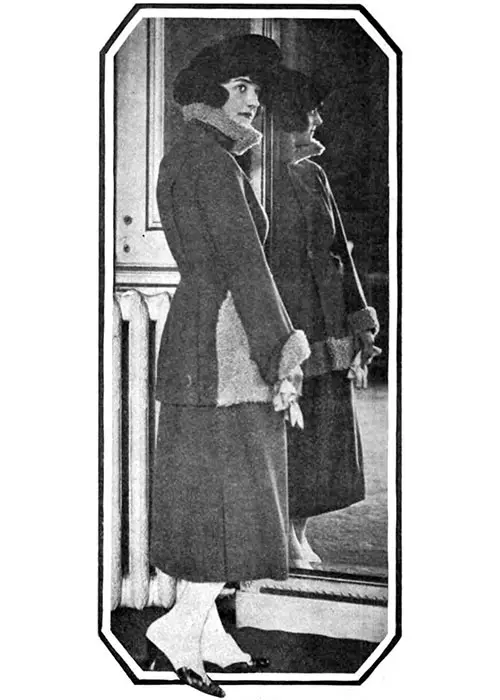Jeanne-Adele Bernard - Parisian Fashion Designer - 1920
Bernard, avenue de l'Opéra, has the reputation of making the best tailored suits in Paris and lives up to it.

Tailored suit of gray duvetyn trimmed with gray lamb fur
One of the largest and best collections of tailor-mades and coats I have ever seen is that shown by Bernard. Although all the other branches of the sartorial art are equally well represented here, the tailleurs stand out as models of elegance.
First on the list are a series of classically cut three-quarter coats and skirts with very much tailored revers, the waistline ever so slightly indicated, fastened with plain horn buttons and edged with braid.
Sometimes double-breasted, they are made of heavy serges, diagonals, cheviots, in nēgre, Havana tobacco, iron gray, dark green and many somber plaids.
Next come the same long lines in lighter stuffs, brocade, satins, and duvetyn, the sides of the coat slightly shirred; the skirt may also have a flat double pleat at either side.
For these suits the collars are high, a dark gray brocade has a tie collar of skunk, although I did see a low shawl collar tied in a bow at the waist.
There is a great deal of fancy braiding, waxed or plain, among the shorter suits. The medium coats with rather wide basques pinched in at the waist are numerous.
One of beige duvetyn has a very large seal shawl collar, the fur going all around the front breadths. Another charming Persian duvetyn wears a standing collar of gray lamb, open in front, the lamb also edging the front panels.
We find much navy and peacock blue among the short, loose coats. Some of the skirts are pleated, a great many costumes embroidered. A new fancy serge is shown in an interesting manner on a short model; the skirt is plain dark blue, the Eton jacket woven in different colored lozenges, like a harlequin's dress.
Coat-wraps may be described as long and straight, with huge armholes and big collars much varied by embroidery and fur. The collars may be deep, standing affairs or so wide that they form shawls at the back when open. Apart from rough stuffs, there are many duvetyns and a lot of cloth, especially in greens.
A jade green duvetyn coat with a big seal collar that ends in a scarf of the goods bordered by the fur is chic; seal edged the sides, which are slit up to the waist and the hem.
Thick serges have vivid lines woven across, forming yokes and collars, the effect very chic. Wool embroidery makes the smartest yokes of all; a beige model has one in two shades of brown reaching to the knees in the back.
Silk chain stitch is also pretty; the reverse effect from yokes is to have fur hems rounding the corners and coming up the sides in points.
Dresses favor the sheath and princess line, the use of embroidery making it easy to fit the stuff to the figure under the patterns. Tinsel or silk and wool cover the whole back or front breadth. One green duvetyn faintly embroidered in jet, fringed in monkey, is pinched in at the waist by long tassels of the fur. These dresses fasten visibly down the front or to one side of the back. Braid done in plaids or diagonals is a frequent occurrence. Scarf collars or straight ones tying in a bow are liked as neckwear.
Among more elaborate gowns there is a new line; a black crepe has a wide apron of the stuff, wrinkled from side to side over the front. The apron is held in place at each side by bright blue braid, the remaining stuff hanging in shells. The same in jade velvet is chic for the evening, the sides of the apron caught in under jet bands.
A dinner gown has a black net blouse, darned all over in bright green wool, with a black velvet skirt.
"Bernard" in the Garment Manufacturers’ Index, New York: The Allen-Nugent Co. Publishers, Vol. II, No. 3, October 1920: 30.
